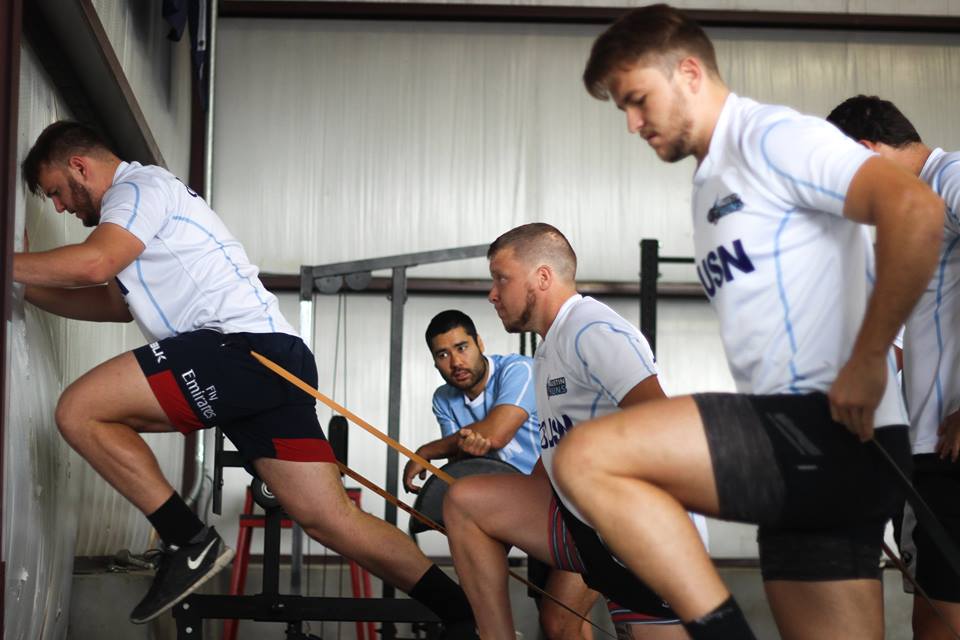Preventing hamstring injuries is a major consideration for strength and conditioning coaches in field sports. Hamstring injuries have a 12-14% recurrence rate, with the re-injury often requiring more days away from training and competition than the initial trauma. Reducing an athlete’s risk of a hamstring injury is therefore one of the most important investments a strength and conditioning coach can make with his training time.
Any sport where a player has the time and space to approach maximal velocity carries the risk of a hamstring injury. Players in a position that requires repeated sprints throughout a game are most susceptible, particularly in late stages of the game when fatigue becomes a factor.
Bilateral asymmetries are an additional risk factor behind previous injuries. James de Lacey of Austin Elite Rugby tests for these asymmetries as part of his pre-season assessments.
“Currently we measure with just a simple single-leg jump test on a jump mat. However, I’ll take a more in-depth approach this season to asymmetries using a relative strength index from My Jump, and measuring single-leg jumps with a PUSH band to have more measures than just jump height. For now, I use the arbitrary 10% difference between legs to decipher whether or not the asymmetry is a risk factor.”
[av_button_big label=’Mark Gillett of West Bromwich Albion: Premier League injury prevention’ description_pos=’below’ link=’manually,https://1080motion.com/west-bromwich-albion-mark-gillett/’ link_target=” icon_select=’no’ icon=’ue800′ font=’entypo-fontello’ custom_font=’#ffffff’ color=’theme-color’ custom_bg=’#444444′ color_hover=’theme-color-subtle’ custom_bg_hover=’#444444′ av_uid=’av-17cd26i’][/av_button_big]
De Lacey prescribes a three-day / week hip extension protocol for athletes with an asymmetry above that threshold. The protocol is based on Scott Brown et al’s 2017 case study, and the players perform the corrective exercises after their regular strength training sessions.
For the entirety of his squad, DeLacey includes eccentric and isometric hamstring exercises throughout the playing year. His pre-season protocols start with lower intensity eccentric hamstring exercises such as drop squats, plate Zercher good morning or eccentric backwards pulls. These are programmed along with more general posterior chain work.
As the players adapt to the eccentric work De Lacey raises the intensity of the eccentric work and adds isometrics. He favors the drop lunge because the eccentric element is unilateral, as well as Frans Bosch-style single-leg isometric work.
The most intense variations include rapid drop-catch eccentrics. These introduce high-speed eccentric loading while having the player “catch” the load with the hamstring in a lengthened position. De Lacey varies his dosing of these exercises throughout the season, working his training cycles around the competitive schedule.
On the field, sprinting is the main form of injury-proofing. De Lacey again applies Bosch’s concepts to altar the environment or task demands. He creates a large variety of task demands to increase the amount of “problem solving” his athletes must accomplish in each session.
[av_button_big label=’Fusing training and testing with the 1080 Sprint at The Hockey Summit’ description_pos=’below’ link=’manually,https://1080motion.com/hockey-summit-1080-sprint/’ link_target=” icon_select=’no’ icon=’ue800′ font=’entypo-fontello’ custom_font=’#ffffff’ color=’theme-color’ custom_bg=’#444444′ color_hover=’theme-color-subtle’ custom_bg_hover=’#444444′ av_uid=’av-tde2bu’][/av_button_big]
Hamstring injuries are a major source of man-games lost in rugby, soccer and other forms of football. Incorporating specific injury-prevention protocols to a team’s strength and conditioning programme can have an outsized impact on player readiness, available, team performance and the front office’s bottom line.
Recommended reading:
Barreira P., Drust B., Robinson M.A., Vanrenterghem J. Asymmetry after Hamstring Injury in English Premier League: Issue Resolved, Or Perhaps Not?, International Journal of Sports Medicine. February 2015
Brown, S.R. et al. The Potential for a Targeted Strength Training Programme to Decrease Asymmetry and Increase Performance: A Proof-of-Concept in Sprinting, International journal of sports physiology and performance. March 2017
Southampton Bring in Hamstring Expert. Training Ground Guru. 22 September 2017.






























































